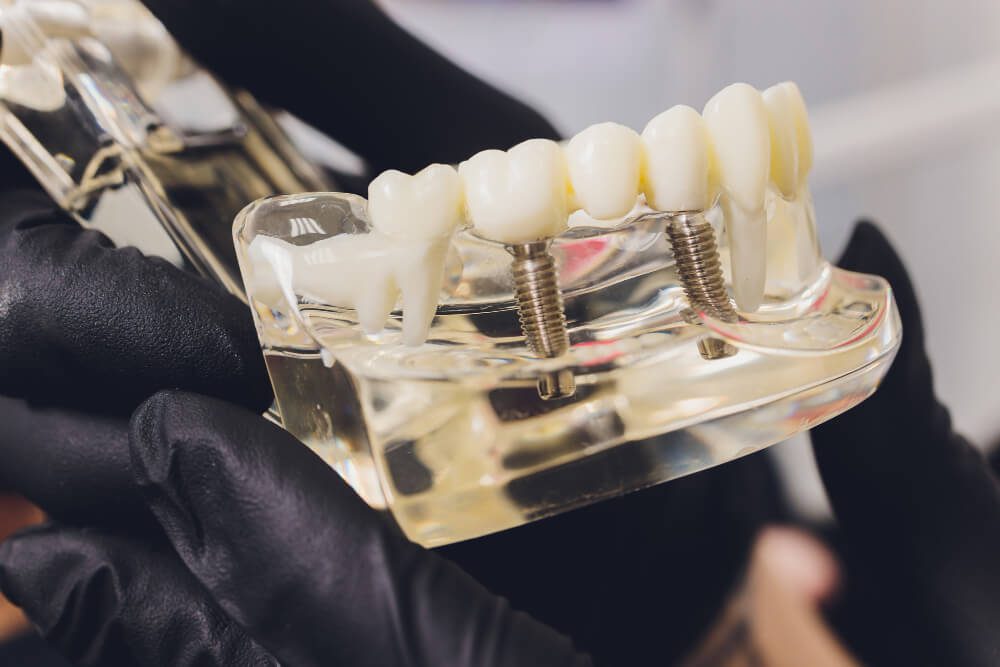Dental Implant Bone Graft — What Is It And When Is It Needed?

A solid foundation of bone is needed for dental implants to look, feel, and function just like natural teeth. However, problems such as a long-term missing tooth or periodontal disease may compromise the required bone height and mass for viable and successful dental implant treatment.
Here is where a dental implant bone graft can help.
Knowing the function of bone grafting will help you make well-informed treatment decisions if you’re considering getting dental implants.
Let us explain how bone grafting can help you achieve a beautiful and confident smile.
What is a dental implant bone graft?
Before your dental implant surgery, your dentist will assess the health of your bone. This is one of the most important steps to ensure the success of your treatment.
If it is found that there is less bone than required for dental implants, a bone graft is used to add volume and density to your bone.
A dental implant bone graft can be obtained from your body, other human or animal tissue banks, or synthetic bone grafting materials. This is packed or augmented on the specific area to prepare it for a dental implant procedure.
When is bone grafting needed?
Bone grafting is the solution for bone loss. This may be included in your treatment plan if:
- It has been a while since you lost your tooth
- Extra jaw height is needed to support a dental implant
- Previous gum disease caused extensive bone loss
- Your jaw needs rebuilding to accommodate the dental implants
Advantages of getting a bone graft
A bone graft is not just a preparatory step—it’s an investment in the long-term success of your dental implant. Here are some key advantages:
1. Increased Implant Success Rate
Bone grafting greatly increases the likelihood of successful implant integration. Studies show that dental implants placed in well-prepared bone have a success rate of up to 97%.
2. Prevention of Bone Deterioration
Tooth loss leads to bone resorption, meaning the bone in that area slowly shrinks over time. A bone graft prevents this by stimulating new bone growth and maintaining facial structure.
3. Enhanced Facial Aesthetics
Bone loss can cause facial sagging, leading to a prematurely aged appearance. By rebuilding the jawbone, bone grafting helps preserve your natural facial contours and improves the final look of your dental implant.
4. Stronger Bite and Chewing Ability
A well-supported implant lets you eat comfortably and enjoy your favourite foods without fear of breakage or instability.
5. Long-Term Dental Health Benefits
Bone grafting supports the implant and reinforces the surrounding teeth and tissues, preventing future oral health complications.

Types of bone grafts
There are several ways in which your dentist can integrate bone grafting into your treatment plan:
Tooth socket preservation
A bone grafting material can be placed immediately after tooth extraction. This is packed into the socket to preserve the bone structure.
Bone augmentation
A thinner and lower bone height is a natural occurrence for teeth that have been missing for a while. A dental bone graft can augment the ridge, increasing its height and volume to accommodate a future dental implant. This is also an excellent solution for generalised bone loss after periodontal disease.
Sinus lift
The maxillary sinus is one of the primary considerations when getting dental implants for the upper back teeth. This is just above that area, and the risk of penetrating it is possible during implant treatment. Your dentist can avoid this scenario by raising the sinus using bone grafting.
What happens after a bone graft?
The next step is recovery once the bone grafting material is in place. Usually, it takes 3 to 9 months, depending on the graft size and your body’s natural ability to regenerate bone.
The new bone fuses with your jaw during this period, giving the implant a solid base.
Post-Procedure Care Tips:
- To guarantee appropriate recovery, strictly follow your dentist’s instructions.
- For the first few days, stick to a soft food diet.
- Take prescribed medicines to manage discomfort and prevent infection.
- Steer clear of smoking since it can impede the healing process.
- Brush and floss the region lightly to maintain proper oral hygiene.
Once your bone graft has fully healed, your Northbridge dentist can place your dental implant, restoring your smile to its full function and beauty.
Is a Bone Graft Right for You?
If you’re considering dental implants but have been told you don’t have enough bone, a bone graft may be the key to achieving a healthy and long-lasting smile. The best way to determine if you need a bone graft is through a consultation with your dentist, who can assess your bone health and recommend the best approach for your treatment.
Discover More About Dental Implants and Bone Grafting
After your initial assessment with our dental implant team at My Local Dentists, we can determine if you will need bone grafting as an adjunct to your treatment. Call us today to learn more!
Dental Implants and Bone Grafting in Northbridge
Call your Northbridge dentist today at (02) 8318 5966 or use our online booking service.
Visit us at Shop 20A Northbridge Plaza, 79-113 Sailors Bay Road in Northbridge.
